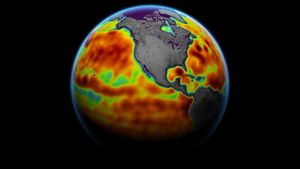A newly unveiled asteroid, 2024 YR4, has ignited excitement and concern among scientists worldwide. Dubbed a "city-killer," this colossal space rock measures between 120 to 270 meters in diameter, hurtling through space at 19.14 kilometers per second (68,904 km/h). Set for its closest approach on December 31, 2032, the asteroid carries a 1.4% risk of collision, prompting experts to pay close attention, always reminded of the devastation from the 1908 Tunguska event.
Scientists from NASA and beyond are actively tracking the asteroid's path, employing advanced modeling and gravitational calculations to predict its future movements. The discovery of 2024 YR4 highlights the importance of planetary defense initiatives tasked with monitoring the skies for potential threats. This proactive strategy ensures asteroids are discovered long before they pose any danger.
Should the possibility of impact become imminent, scientists propose fascinating deflection methods such as kinetic impactors—spacecraft intended to collide with the asteroid and nudge it off course—and gravity tractors, which would use gravitational forces to alter the asteroid's path. NASA's recent successful Double Asteroid Redirection Test (DART) mission, where they crashed a spacecraft deliberately to change the orbit of an asteroid, showcases the potential effectiveness of these strategies.
Yet, it is important to note the reassurance experts provide: there is no immediate danger from 2024 YR4. Our planet regularly encounters smaller space debris without consequence, and occurrences of significant asteroid impacts are exceedingly rare.
Over the years, systems for monitoring near-Earth objects (NEOs) have improved dramatically. NASA’s Near-Earth Object program provides sophisticated tracking methods, though challenges still persist, especially concerning accurate predictions of asteroid paths due to gravitational interactions from other celestial bodies.
The emergence of such asteroids as 2024 YR4 raises questions about humanity's preparedness for potential impacts. Experts advise on potential solutions to mitigate the danger should it arise. While kinetic impactors and gravity tractors are among the proposed techniques, more extreme options, like nuclear deflection—which would involve detonations near asteroids—remain on the table, albeit sparingly and only considered if absolutely necessary.
Despite sensational headlines surrounding the potential threat from asteroid 2024 YR4, many believe the actual risk level is manageable. It serves as merely one of many reminders of natural disasters we must factor in within the broader spectrum of risks humanity faces. Statistical analyses from the Future of Life Institute demonstrate just how low asteroid impacts occur when compared to other existential risks, such as pandemics and nuclear threats.
Indeed, most large impacts from asteroids have been estimated to happen once every few million years, with no immediate peril from any large extinction-level objects projected on collision courses with Earth anytime soon.
While this asteroid advances forward, scientists remain vigilant and prepared, showing us the importance of constant monitoring and public education initiatives aimed to engage communities. There’s growing support for citizen science participation, with many encouraged to contribute by tracking and observing these astronomical bodies from their own backyards.
Reconnaissance of asteroids like 2024 YR4 emphasizes the necessity for global collaboration against potential celestial threats. Such efforts must continue to deepen cooperation among nations, pooling resources to develop effective strategies for monitoring and possible action against NEOs.
For now, as the asteroids travel through space, researchers reinforce the notion of constant vigilance, with advanced telescopes tirelessly watching our skies. The combined efforts of international space agencies position humanity to effectively safeguard our planet against cosmic surprises and unknown forces, ensuring we are always prepared to navigate whatever the cosmos may bring.



